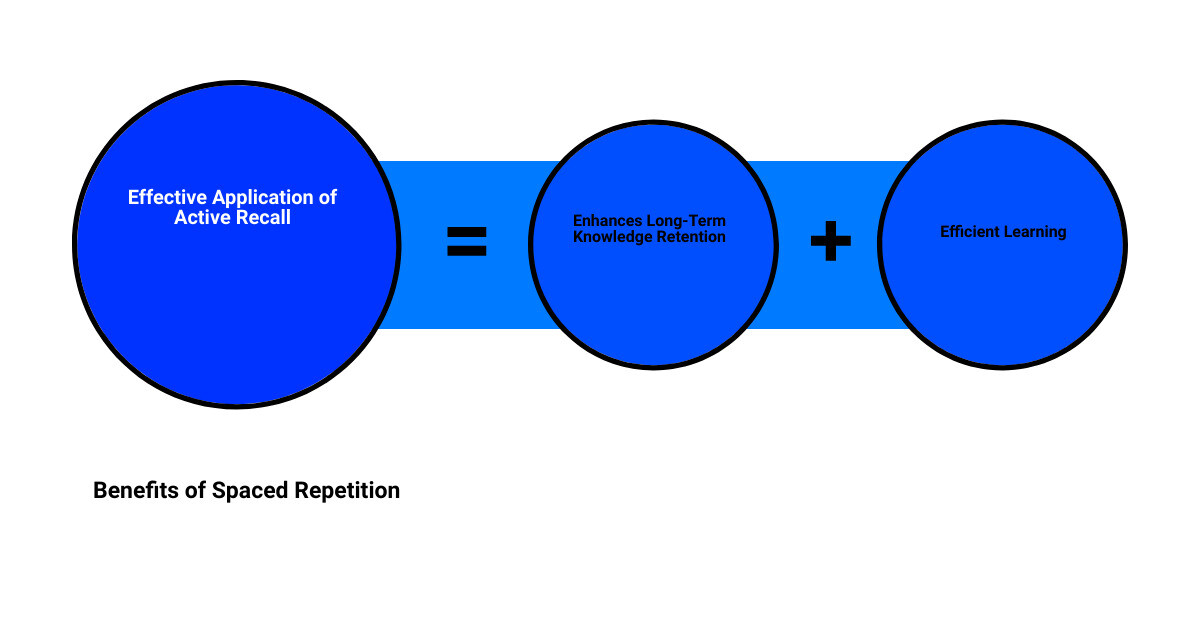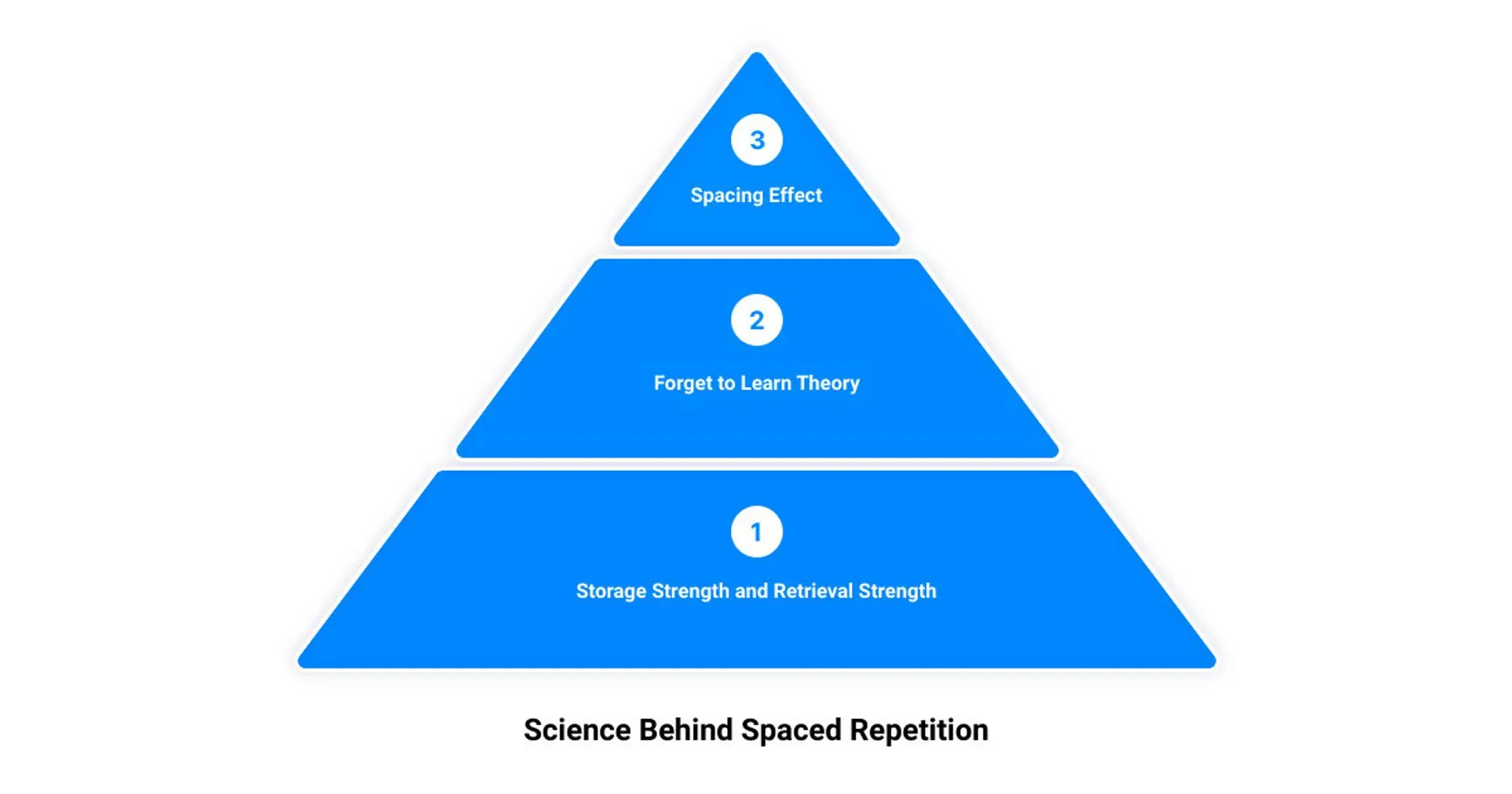Imagine yourself as a fitness enthusiast stepping into the gym. You wouldn't expect to lift the heaviest weight on your first day, would you? Instead, you'd start with lighter weights, gradually increasing the load over time to build your strength. Now, envision your brain as a muscle. Just like physical training, your brain needs a scientifically-backed technique to effectively learn and remember information. This is where the spaced repetition learning technique comes into play.
The spaced repetition learning technique is a revolutionary approach to learning that maximizes your brain's potential. This powerful technique is akin to a gym workout for your brain, helping your mental muscles get stronger and sharper with each repetition. The concept is simple: review and recall information at gradually increasing intervals. If you remember the information correctly, the time before the next recall is doubled. This technique is designed to help embed the information more firmly in your long-term memory, enhancing retention and recall.
Whether you're an eager student preparing for exams, a professional striving to stay on top of industry knowledge, or a lifelong learner trying to master Mandarin, the spaced repetition learning technique can transform your learning experience. With this method, you're not only learning more but learning smarter, faster, and more efficiently.
In this article, we'll delve deeper into the science behind spaced repetition, explore its benefits, and provide practical tips on how to incorporate it into your learning routine. We'll also introduce you to Traverse, a revolutionary learning app that combines mind mapping, spaced repetition flashcards, and connected note-taking, providing an optimal space for you to unlock your learning potential.
Stay tuned to discover how the spaced repetition learning technique can revolutionize your journey to mastering new knowledge, be it Mandarin Chinese characters or complex scientific theories.
Understanding the Science Behind Spaced Repetition
Imagine having a secret key that can unlock the door to effective learning. That key is understanding the science behind spaced repetition, a technique that leverages cognitive science principles to optimize information retention.
The Concept of Storage Strength and Retrieval Strength
At the heart of spaced repetition lies the dual-strength theory, which asserts that memories have two kinds of strengths: storage and retrieval. Storage strength refers to how well information is embedded in our memory. This strength doesn't fade away with time; instead, it can only be amplified through repeated recall or use.
On the flip side, retrieval strength pertains to our capability to access stored information or memories. Unlike storage strength, retrieval strength is ephemeral and requires continuous maintenance to prevent decline.
The "Forget to Learn" Theory
In line with this concept is the theory of disuse, often dubbed the "Forget to Learn" theory. This theory suggests that forgetting is essentially an accessibility issue rather than an issue of lost storage strength. The memories are still stored in our mind's vast library, but we struggle to locate them. This is where spaced repetition steps in as the crucial 'maintenance' process, keeping our mental catalog organized and accessible.
A key principle of the "Forget to Learn" theory is that the bigger the drop in retrieval strength, the greater the increase in learning when the memory is accessed again. This principle, known as desirable difficulty, forms the bedrock of why spaced repetition is so powerful: it helps maximize desirable difficulty, thus optimizing learning.
The Spacing Effect and its Role in Learning
Another integral concept in the science of spaced repetition is the spacing effect. This phenomenon implies that our brains learn more efficiently when our study sessions are distributed over time. This method allows our mental 'mortar' to dry, solidifying new knowledge and making the learning process more effective.
The spacing effect is closely tied to the concept of desirable difficulty, which contends that learning is most effective when it's challenging but not too hard. Consequently, spaced repetition, with its gradually increasing review intervals, provides just the right amount of challenge to keep our brains engaged and our learning optimized.
In essence, the science of spaced repetition sits at the convergence of the Ebbinghaus forgetting curve, the dual strength theory, and the spacing effect. By understanding and utilizing these principles, we can tap into the power of our brains, transforming the way we learn and remember. For lifelong learners aiming to master new knowledge, such as Mandarin Chinese characters, understanding the science behind spaced repetition can be a game-changer.

The Benefits of Spaced Repetition Learning Technique
The spaced repetition learning technique is more than just a study strategy—it's a scientifically validated method to supercharge your learning and long-term memory retention. When it comes to learning complex subjects like Mandarin, spaced repetition presents a potent tool for enhancing your learning efficiency. Let's explore this further.
How Spaced Repetition Enhances Long-Term Knowledge Retention
When you use spaced repetition, you're essentially training your brain to keep a piece of information stored longer in your long-term memory. It's like laying bricks to build a wall; if you stack the bricks too quickly without allowing the mortar to solidify, you'll end up with a weak structure. By spacing out your learning sessions, you allow your mental mortar (memory) to solidify, thereby improving memory retention.
The recurring review sessions in spaced repetition ensure that new information is consolidated with related knowledge that's already been stored in your long-term memory. This makes it easier to retrieve and recall the information at later dates, thereby enhancing long-term knowledge retention.
The Efficiency of Spaced Repetition in Learning
Spaced repetition is all about efficiency. By introducing calculated intervals of forgetting, you maximize the principle of desirable difficulty. This suggests that a certain level of difficulty in retrieving a memory is beneficial for learning. The process of struggling to recall information strengthens the memory, making it easier to retrieve in the future.
This precision in timing your reviews reduces the time you spend relearning forgotten information and improves your ability to retain new information over the long term. Studies have shown that spaced repetition can enhance learning efficiency by up to 74% compared to cramming or massed practice. In essence, with spaced repetition, you're making your study time count.
The Role of Active Recall in Spaced Repetition
Finally, a key component of the spaced repetition learning technique is active recall. Instead of passively re-reading the material, you are asked to actively recall the information. This act of retrieving the information from your memory further strengthens the memory traces, making the information easier to recall in the future.
Research shows that active recall is a potent enhancer of long-term memory, making this method 51% more effective than passive re-reading and 93% more effective than doing nothing. This makes spaced repetition not just about memorizing facts for a test, but about truly understanding the material and retaining it for a long time.
In summary, the benefits of spaced repetition in learning are numerous. From enhancing long-term knowledge retention and improving study efficiency to leveraging the power of active recall, spaced repetition can be your secret weapon in mastering complex subjects like Mandarin.

Implementing Spaced Repetition in Your Learning Routine
Ready to take your learning approach to the next level with the power of spaced repetition? Let's dive into how you can effectively incorporate this proven technique into your study routine, specifically when learning Mandarin Chinese.
Optimal Spaced Repetition Time Intervals
In the world of spaced repetition, timing is everything. The spacing intervals between your study sessions can dramatically impact your learning efficiency and long-term memory retention. The optimal intervals for spaced repetition depend largely on factors such as the difficulty of the information and the date of an upcoming exam. However, a common algorithm suggests repeating the information on the first, seventh, sixteenth, and thirty-fifth day after learning. This schedule strikes a balance between reinforcing your learning and giving your brain the necessary time to consolidate and store information.
The Use of Flashcards in Spaced Repetition
Flashcards are a classic tool that packs a punch when combined with spaced repetition. They facilitate active recall, a process that strengthens your memory and understanding of the material. This is particularly beneficial for learning Mandarin Chinese, where mastering characters and vocabulary is crucial.
Digital flashcards, like those employed by Traverse, are a particularly efficient method of spaced repetition learning. The Leitner System, a time-tested method that optimizes the use of flashcards, can further enhance your learning experience. This system sorts flashcards into boxes based on your familiarity with the content, allowing for more frequent review of challenging information and strengthening of already grasped knowledge at spaced intervals.
Steps for Implementing Spaced Repetition
Implementing spaced repetition in your learning routine involves several steps. First, plan the spacing intervals of your study sessions, taking into account your schedule and the nature of the material.
Next, study and review the information for the first time. This initial exposure is crucial for setting the stage for successful recall in the future.
The third step involves recalling the information at the first spacing interval. The first repetition should be shorter, focusing on recall rather than learning new material.
Finally, it's all about repetition. Keep recalling the information at the chosen spacing intervals, diligently sticking to your schedule. Remember, spaced repetition isn't magic. It requires time, effort, and consistency. But when you start seeing the results, you'll understand why it's considered a revolutionary technique in effective learning.
Using spaced repetition in your learning routine can be a game-changer, especially when you're mastering complex subjects like Mandarin. With the right timing, the use of flashcards, and a consistent approach, you'll be amazed at how effectively you can unlock your learning potential.
Spaced Repetition Learning Technique in Practice: Case Study of Traverse App
Traverse: A Revolutionary Learning App
Imagine a tool that not only streamlines your learning process but elevates it, making it more efficient and effective. Meet Traverse, a revolutionary learning app designed to amplify your learning potential. It's not just another app; it's a state-of-the-art learning platform that harnesses the power of cognitive science to help self-learners master anything they set their minds to.
How Traverse Combines Mind Mapping, Spaced Repetition Flashcards, and Connected Note-Taking
Traverse is a unique blend of three powerful learning techniques: mind mapping, spaced repetition flashcards, and connected note-taking. Each of these components plays a vital role in the learning process.
Mind mapping helps you visually organize information, making it easier to understand and remember. Spaced repetition flashcards, as we've discussed, are a powerful tool for long-term knowledge retention. This technique ensures that you review information just at the point of forgetting, thereby strengthening your memory.
Finally, connected note-taking allows you to create connections between different pieces of information, enhancing your understanding and aiding recall. Traverse seamlessly integrates these techniques into a single, user-friendly platform.
The Benefits of Using Traverse for Learning Mandarin Chinese
Traverse is an exceptional tool for learning Mandarin Chinese. Languages are complex, with many interconnected pieces of information. Traverse's connected note-taking allows you to link related characters, phrases, and grammar rules, enhancing your understanding of the language.
Moreover, the spaced repetition technique is particularly beneficial for learning Chinese characters. Traverse's flashcards break down the daunting task of memorizing thousands of characters into manageable chunks, reviewing them at optimal intervals to ensure they're committed to long-term memory.
Importing Anki Decks into Traverse for Continued Learning
One of the standout features of Traverse is its Anki Importer. Anki is a popular flashcard app used by many language learners worldwide. If you're already using Anki, you can import your Anki decks directly into Traverse and continue learning. This compatibility means you don't have to abandon your previous efforts and can seamlessly transition to using Traverse.
In conclusion, Traverse is more than just an app. It's a scientifically-backed, comprehensive learning tool that empowers you to learn Mandarin Chinese or any other complex subject efficiently and effectively. So why wait? Harness the power of spaced repetition with Traverse and unlock your full learning potential today.
Conclusion: Unlock Your Learning Potential with Spaced Repetition
In the realm of learning, few techniques hold the transformative power that spaced repetition does. By integrating this science-backed strategy into your learning routine, you're not just absorbing information more efficiently - you're revolutionizing your entire learning process. And when this potent technique is combined with the innovative features of the Traverse app, it becomes an unstoppable force in the hands of any dedicated learner.
The beauty of spaced repetition lies in its simplicity and its effectiveness. It's not a magic pill, but a well-researched, evidence-based approach to learning that hinges on our brain's naturally adaptive mechanisms. It leverages our cognitive strengths, aiding in the consolidation of new information and enhancing our long-term memory recall.
Utilizing spaced repetition doesn't mean you're working harder; it means you're working smarter. You're optimizing your learning periods, using time to your advantage, and strategically strengthening neural connections that lead to better knowledge retention.
If you're eager to learn Mandarin Chinese, Traverse's unique blend of mind mapping, spaced repetition flashcards, and connected note-taking presents a dynamic learning landscape. With the ability to import Anki decks, your study materials are always within reach.
But the true value of Traverse lies not just in its features, but in its commitment to making learning a more enriching and productive experience. It understands that every learner is different and strives to provide tools that cater to unique learning styles and preferences.
In the end, your learning journey is a personal one. It's about you, your goals, and the paths you choose to reach them. With spaced repetition and Traverse, you're not just taking control of your learning - you're unlocking your full learning potential.
So, step into the future of learning. Embrace the power of spaced repetition, explore the innovative features of Traverse, and transform your learning journey into an enriching, rewarding pursuit. Because with the right tools, the power to learn is truly in your hands.

